5 Things Found in Progressive Amish Communities
Last month we explored 5 common features of the most conservative Amish communities. Today let’s have a look at 5 things found in the more progressive Amish communities.
The term “progressive” comes with a caveat, as the word can refer to different things. For instance this could mean materially progressive – meaning allowing higher levels of technology, or, we could mean progressive in a religious sense.
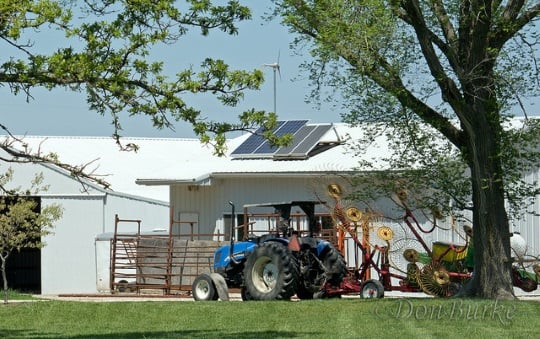
Also, a community might also be materially conservative but have progressive features in spiritual areas (for instance, Aylmer, Ontario, which is materially plain, but which also has Sunday School, unusual for most Amish). So putting churches into “progressive” and “traditional” categories is not always so clear-cut.
With that in mind, here are some individual features that can be considered signs of a more progressive Amish church community.
Five Features of Progressive Amish Groups
1. Cell Phones & Smartphones – The common standard among Amish (though not accepted by all) is to have a landline phone in a shanty, which may be shared by multiple families, or a phone housed in an outbuilding like a shop or barn.
Cellphones and especially smartphones are controversial among the Amish, but they can be found in numerous communities. Smartphones especially are seen as a threat due to their internet capability.
As a general rule, business people are going to be more likely to own cell/smartphones. The rationale is that they area necessary business tool, though not all Amish would agree on how essential they actually area.

Amish owners of mobile phones may follow certain rules about their use, such as only having them on during certain hours and/or leaving them outside of the home.
However this one is not so cut-and-dry. There are cases where some otherwise conservative Amish use cell phones. At least one group of the otherwise traditional Nebraska Amish permits them, and there are probably other examples of this in otherwise conservative groups.
2. BRIGHT Buggies – Buggies in more materially progressive communities tend to be significantly more illuminated. Some of these buggies are lit up like a fireworks display, with strobe lighting on top to go along with multiple flashers, animated turn signals, and extensive reflectors.
Some have lighting along the undercarriage as well. Of course some of these are youth buggies, which tend to be gaudier and may be decorated with additional reflectors and decals, but in some places bright buggies are just the standard. Northern Indiana is one settlement where this is common. Brighter buggies are an unsurprising response to the all-too-common problem of road accidents resulting in injury and deaths.
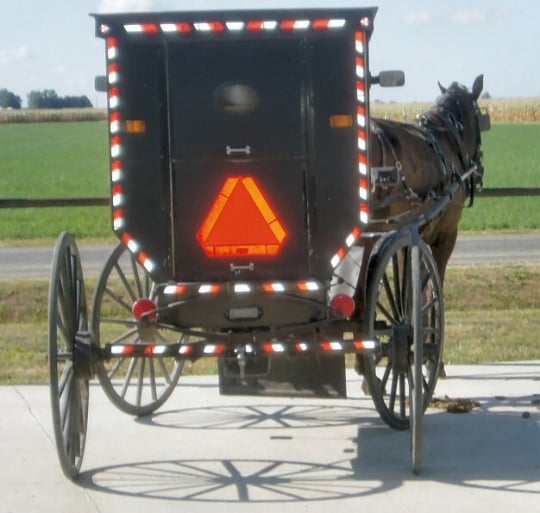
These buggies stand in sharp contrast to the plainest Amish buggies, which have but a few meager strips of silver reflective tape, no SMV marker, and a single lantern hung on one side.
3. Mission Work and Outreach – Amish stand in contrast to those evangelical Christian denominations with an aggressive orientation to outreach and converting new adherents. The vast majority of Amish expansion comes from natural growth, with large families and high retention into the faith.
Amish are generally not looking for converts and tend to be oriented toward their own communities first and foremost (though conversion to Amish Christianity does occasionally occur and seekers are accommodated to varying degrees).
However there are examples of both mission work and an evangelical-style outreach, and this is more pronounced in the “higher” Amish groups. The Amish experienced a controversial mission movement in the mid-20th century, echoes of which are seen today most prominently in the New Order churches.
As noted in An Amish Paradox, the New Orders are “clearly the heirs” of this movement, and “Many New Order individuals exhibit a missionary zeal that is sometimes difficult to distinguish from that of the Beachy Amish” (p. 60).
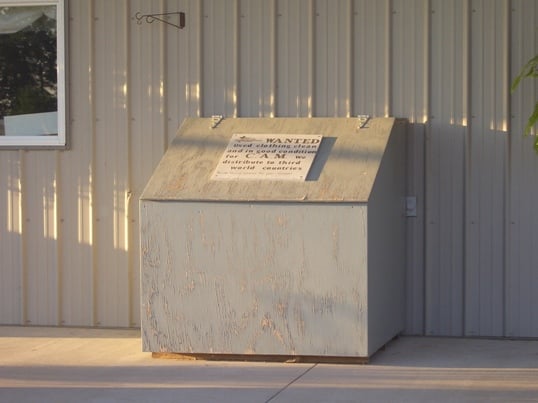
This manifests itself in various ways among New Orders, including support of international relief missions and ministries, and openness to potential converts.
Another example of outreach supported by both New Orders and mainstream Old Orders is the two-decades-old project to help improve educational standards among Old Colony Mennonites in Mexico.
Both New Order Amish and mainstream Old Order churches support humanitarian efforts such as food drives and disaster relief, for instance projects led by organizations such as Christian Aid Ministries (CAM) or Mennonite Central Committee (MCC).
In the case of the diverse Holmes County, Ohio community, this involvement is shown to decrease the further one moves toward the conservative end: “Moving down the Anabaptist escalator, the stance of the Andy Weaver affiliation and the various Swartzentruber branches toward mission work is much more cautious, if not negative” (p. 63).
While individual donations by members of these groups may happen, “taking on an administrative or even a volunteer role for mission activities is less common for the Andy Weavers and almost unheard of for the Swartzentrubers” (p. 63).
4. Air Travel – Amish travel by airplane or helicopter only in extenuating circumstances (usually meaning medical emergencies).
If you’re an Amish person, just about the only time you’ll find yourself in an airborne vehicle is when you really don’t want to be. This might mean a LifeFlight to the nearest major medical center, probably because you’ve had a farm accident or other medical emergency.

But New Order Amish generally do permit air travel, and fly for different reasons which can include business or mission trips. For example, members of one New Order church had journeyed to places as far afield as Indonesia and Africa.
5. Liberal Use of Tractors – Most Amish who use tractors kneecap their functionality by prohibiting them from being used in the fields. The tractor is typically parked and used for its engine to power various machinery, such as feed grinders, manure pumps, and to blow silage to the tops of silos.
This preserves the importance of horses to Amish farming and discourages the use of these car-like vehicles on the roads. Getting too comfortable with driving a tractor around can eventually slowly lead to them becoming de facto road transport.
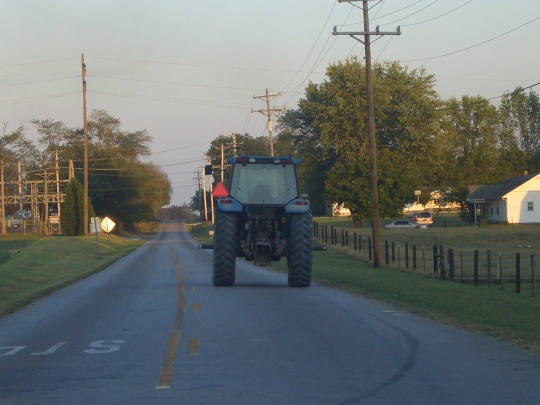
But there are some communities who do make liberal use of tractors in these ways. They include Chouteau, Oklahoma; Guthrie, Kentucky; Kalona, Iowa; and Garnett, Kansas.
In some places you’ll see the steel-wheeled tractors which are permitted to be used in the fields but which are unwieldy as far as a road vehicle. In others the tractors are of the air tire variety which make them considerably more asphalt-friendly. In some of these places, buggies are relegated to primarily Sunday use.
Other signs
These are some of the progressive markers you will see in certain communities.
Other things we could include are use of public electricity in homes, presence of Sunday School, solar panels, a more progressive educational curriculum, close-cropped hair and beards, dresses in bright shades of yellow and red (vs. darker hues like purples and browns), and abstinence from tobacco and alcohol.

Just because a community has a given feature, doesn’t mean it’s automatically a “progressive” settlement, but generally the more of these you see, the more likely that the term would make sense for that group.
If you missed it the first time around, here’s the 5 features of the plainest Amish communities post.






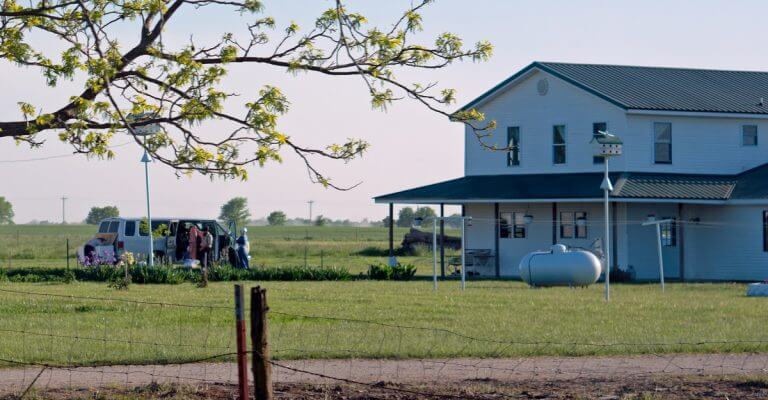
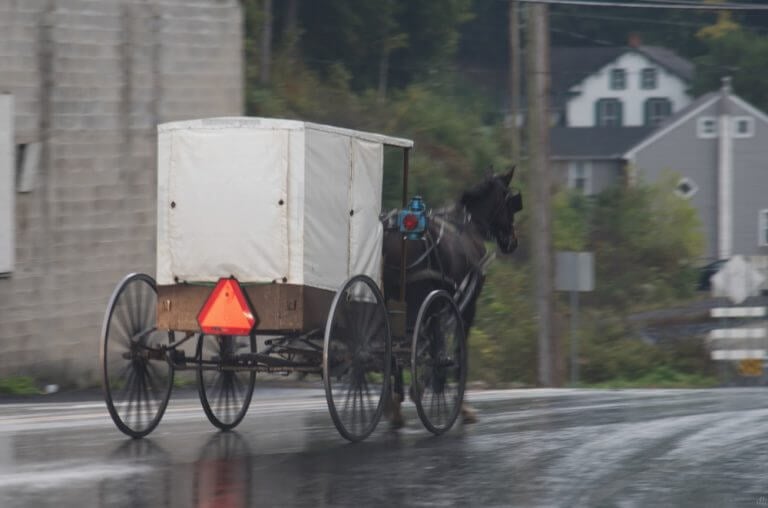

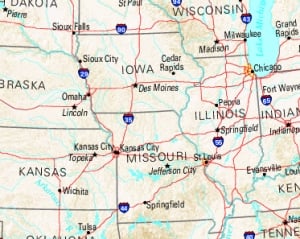
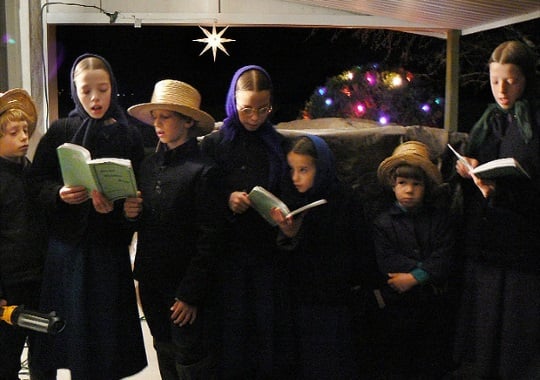
McKean County
Are the Amish going to move into McKean County PA,
I haven’t heard anything James, but with the way the Amish are growing and migrating, I wouldn’t be surprised. Looks like a pretty rural county, and there are Amish in adjacent counties (quite a few in Cattaraugus Co in NY; Allegany County NY; also Potter, Forest, Warren Counties).
Elkhart County Progress
1. Cellphones/smartphones are very common among the Amish here, especially the young. They are on them constantly, much like the English kids. I’m sure they are used in the homes, too.
2. The brighter markings really do help drivers see the buggies at night, and during the day the markings are hardly noticeable. It seems to be a good compromise for now.
4. The Florida Pioneer Trail bus is very popular at this time of year. It comes from Illinois and stops throughout Indiana, then arrives in Sarasota about 24 hours later, and then makes return trips. It runs through a couple times a week and permits more luggage than airlines. It’s used by both Amish and English, but mainly Amish.
5. I’m starting to see the tractors now, but the bobcats and loaders really became popular in the last several years when the elders permitted the owning of them. Some Amish near here started a rental business with various machinery types and sizes. It became very popular, especially among the Amish because they could rent equipment, but not own it. The hay balers today put out the huge bales that cannot be moved by hand, so the bobcats are used to move them to feed livestock. Maybe this spring I will see some tractor use in fields.
Thanks for this Elkhart County report, Barb! I thought about mentioning the skid loaders which are common in some communities. Possibly the brightest buggies I’ve ever seen were in the Elkhart/Lagrange area.
Horse Changes
If another category of change is explored, I hope you elaborate on the many various breeds of horses the Amish now use. I’ve seen some very expensive looking stock in the last several years.
Barb that is a neat idea, especially since I know we have horse enthusiasts floating around these parts, but I don’t think I am the one to write that one, I’m just not a horse person. So might need to outsource it, if there are any guest posters out there who have an interest in the topic 😉
Horses
There are still a lot of Amish using standardbreds but in our community we see a lot of Morgans, Friesens, Dutch Harness and so on and you’re right that some are expensive. If you go on Youtube you can watch some horse auctions and see the excitement AND the prices.
Amish responsibility
Why do Amish think it’s ok to have non-Amish people to help them out but if they get hurt helping Amish out they don’t take responsibility for it?
Hi Peg, not sure what you have in mind here.
English helping people
I have new 5 month’s neighbors. I treat them like family .If they need something Iam there for them ,like they are for me .We break bread together at each others home .Share bake goods ,both ways . He helps split wood for us ,no $$ exchanged.
Geauga and Trumbull Co Ohio
In our area, I’ve seen some of it all. In an Old Order community, cell phones are allowed to use for business, no problems.
This past year was the first I’d seen an Amish man on a tractor, and then I saw a couple more soon after.
Most buggies here have reflecting strips and some have lights.
I don’t remember seeing any Amish at the airport but I see a lot of them at the Home and Garden Show and the Boat Shows.
Last but not least, at the Geauga Co Fair, I’ve seen them selling solar panels and photovaltaic batteries.
They get around and have their feet on the beat same as the rest of us.
Thanks Kim, interesting. I don’t think any Amish in Geauga Co. would fly. There is a more conservative segment in the settlement, but overall sounds like approach to technology is fairly mainstream to progressive. It’s been some years since I’ve been there.
Five Things in Progressive Communities
Before I read the article I thought of my five things. I came up with cell phones (not many smart phones but tons of flip phones), sporty decals on buggies (I’ve even seen the Ford Mustang decal on a buggy dash board), Flip flop sandals in season, solar panels for charging Dewalt tool batteries (these batteries are now used to provide buggy lights) and small photo electric calculators. I also see bicycles in Progressive communities, scooters in moderate orders and neither in the strict communities.
Interesting list Jerry! If you want more decals we have a few here:
https://amishamerica.com/amish-buggy-decals/
Haven’t seen as many flip flops as I have the strap sandal style.
Yoder, Kansas Amish
The Amish in Yoder use their tractors for commuting to work and to Hutchinson for shopping. They install special cabs and pull custom trailers to carry their family members and other things with them. They travel rather long distances by tractor. I have Amish family and grew up among the Amish of Indiana, Michigan, and Pennsylvania, but I was not aware of this practice until moving to Kansas.
This story is about an Amishman who commutes to his job at the Reno County Courthouse in Hutchinson, 12 miles each way, in his tractor:
http://www.hutchnews.com/d5fe5618-55d7-5eaa-8bd4-3b1219c4ded9.html
I was also quite shocked to learn recently that at least some of the Yoder Amish can own and drive their own trucks for work. I talked to an Amish family in our local Walmart, and they told me they moved to the community specifically because of that rule.
I know that Amish will own work trucks in some Indiana and Ohio districts, but the driving is always done by a child or acquaintance who has not joined the church.
Last comment: when I was in Holmes County, Ohio, for an Amish funeral last year, I talked to an Amishman who installs solar systems in Amish homes. He said some Ohio districts now allow full off grid solar systems. The houses are lighted and powered much like conventional homes, but they are fully powered via solar panels and batteries. I was not familar with this practice either. There have been so many changes since I was in more frequent contact with Amish communities. It’s not that different from the many technological changes the rest of us have experienced over the last twenty years. Twenty years ago, my high school job was as an Amish taxi driver for a construction crew before and after school (and working with the crew during the summer). It was a big deal for the Amishman to get a mobile phone that plugged into my van. It saved so much time to be able to call for concrete and building supplies from the job site. It’s hard to resist the convenience of some of these technologies.
Driving trucks for work
Really interesting comment, Jason. Amish driving for work is also seen in Garnett, KS. Apparently this was also a thing at one time in Arthur, IL, but was gradually phased out.
I was told that in Garnett that employers actually own the vehicles, but that the Amish do drive them for work purposes. I’ve also seen ownership of work trucks in Lancaster County, but no driving by Amish.
I was not aware of the off grid solar system development in OH, interesting. Will be sure to ask about that next time.
Grabill Amish
The Amish in Grabill, Indiana are Old Order, but they have solar power, wind power, smartphones & landline phones in the house.
Allen County Amish (Grabill)
Thanks for mentioning this community, Lisa. Materially it is an interesting place – large brick homes are common, solar and wind power as you say as well. I understood that mobile phones were common but had not heard that landlines were typical as well? As far as solar and wind, the Grabill community inspired this post several years back: https://amishamerica.com/amish-solar-power/
On the other hand this is a Swiss Amish group which still uses the open buggy (no covered buggies, unless there is a district or two that has started to adopt them, as has been the case in the related Swiss Adams County settlement recently).
https://amishamerica.com/what-is-this-buggy-doing-in-adams-county-indiana/
Grabill & Berne Amish
I used to make frequent trips to Berne, Indiana to photograph the Amish farms & buggies. I’m not a professional photographer, but I enjoy it. We are closer to Grabill now & have made some Amish friends there. Several of us from Facebook Amish groups got together & started having meals at an Amish farm there. The gatherings have grown each time we go. Not only are there more Englishers that go, but the Amish family we have the meal with also invites extended family & friends. They are as curious about us as we are of them. We are set to go again in mid May. We always contribute $20 per person, even though the family doesn’t ask for anything, money-wise. If the weather permits, we get to take buggy rides. https://www.facebook.com/lisascountryphotos/videos/vl.1336644986371791/1730237200552654/?type=1
That sounds great Lisa! Thanks for mentioning it. You might get some more attendees from this post. Do you promote it on Facebook as well?
Grabill Amish
No, we don’t. It started out with FB Amish group members that lived relatively close & it has pretty much stayed that same group of people. One of the ladies is good friends with our Amish host, Miriam, & they get together & decide on a day then Pat gets with all the regulars to see if that date will work. Last summer, we weren’t able to get together with them at all.
When I was in the Elkhart/Lagrange, Ind., settlement for several weeks last year I was surprised to observe the number of Amish of all ages exercising at fitness centers and the number of Amish in their teens using a tanning salon.
Interesting, Al, especially the fitness centers. I might have to update this post: https://amishamerica.com/how-do-amish-exercise/ especially the bit where I expressed doubt at Amish joining Plain gyms anytime soon, guess something like that is happening 🙂
I remember being surprised at the time to see the exercise equipment in the basement photo on that post, but why not.
Don’t forget about battery bikes. 🙂
Yes, I forgot about the battery assisted bikes! The women I spoke to in Holmes County, who had recently started using the bikes, talked about how much easier it was to travel intermediate distances that used to require a horse and buggy. They spoke of it as empowering women to be able to go places they wouldn’t have necessarily gone before.
The site of a bicycle zipping unnaturally fast up a hill was puzzling to me until I learned about the battery assist.
I’ve had mine for about 3 years and would not want to do without. It’s faster and easier than a normal bike or a horse and I use less drivers. I can zip up a hill pretty easy and get to work without being all sweated up or tired.
Look also at things like “hostess parties” like for Tupperware or 31 bags, Princess House and all that.
Tractor Driving Maniacs!
In my area, Amish have been allowed to drive their tractors everyday, except Sundays, for some time. They also have had electric in their homes, even had a FEW people join in their community. I don’t see nearly as many Amish in our area, as I did when I was a kid. Maybe they are blending in, or moving more to Mennonite ways. Anyway, Gortner, MD in no longer the Amish community it used to be.
Betsy, to be honest I was a bit confused here as the title of your comment suggests that you don’t have a high opinion of the way Amish drive tractors in your community, but I didn’t see that elaborated on in the comment.
I believe you are referring to the community in the area of Oakland…it is one of the most progressive communities as it is considered an “electric New Order” community.
There was an article not too long ago in The Guardian about a couple of people who joined this community: https://amishamerica.com/amish-converts-in-the-oakland-maryland-community/
Also here is a video of the congregation singing at a funeral. It was held at the community meetinghouse, another unusual thing for Amish:
https://amishamerica.com/tiny-houses-loren-beachys-plain-side-and-the-amish-at-oakland-maryland/
Old or new
If old order is conservative and use cell phones and electricity or tractors I’m wonderong what they will be like in coming years.I’m ashamed to be using this cell phone right now myself. Sometimes i wonder why amish people aren’t more self sufficient seeing as many own farms. I don’t know why they shop at walmart and such except one issue that is true for me is not comprehending the art of fabric making for clothes we all wear. Ive seen someone spin wool herself but making a finely weaved fabric must be done by machine?? Amish people might always wear the traditional clothing in the future to look amish. i don’t know. I admire their lifestyle however i think some hate outsiders yet they aren’t so different as they might believe. I have no idea what it might be like to be a more isolated, conservative amish person seeing the insanity of what is on tv and what popular songs sound like at times. I hope some amish people stay away from electricity and cars and such except sometimes i wonder about how horses feel about working too much. Anyone know the life span of a horse? I also think some look fine driving the buggies. Well God bless the amish, for certain. I hope they see how much people admire them even if they think english people are evil. I’ve read atleast one account of amish-black racism and it related to a story about Ham in the bible and I wondered if amish people teach that as a tradition and it was not right to ponder. At the Bird in Hand market there were several african-americans. They seemed to love the feel of the place and I loved seeing them there myself. It shouldn’t be a big deal but it was. Amish and Hamish are similar words. I also heard on a tour there that homes in the area, I assumed Amish, were used for the underground railroad. Well I certainly rambled off topic here but I think my fascination with the amish is perhaps not based on perfection, it probably is the lack of electricity and the religious focus and I do like the clothes.
You mentioned several subjects, Me. I’m Amish and I sure don’t think of non-Amish people as evil. I have friends who are not Amish and I respect them and know that they aren’t perfect but neither are the Amish. I don’t know of any Amish people who look down on someone for being a different color but I will admit I live in a more progressive community where tourists from all over the world come so I see every color possible. I do know that in years gone by people is more rural areas — Amish and not — had a less accepting attitude to other races or cultures and that is sad. Walmart? We shop at Walmart about every 6 weeks. If possible we prefer local stores but somethings we stock up on at Walmart. For our family it’s often things we can’t get in the local stores or are much cheaper at Walmart. Some go to Walmart more often than our family many go less often. I don’t think it would be fair to say our horses work too much. We have two and we trade them off plus we use a bike a lot. Our one horse was used twice this week and not over 5 miles on each trip. The other has not been used at all. A horse can be like a person and want to get out and work out. 🙂 A horse that does not get enough work can act over excited when it does get used. Like its hyper! Our group is very careful about cell phone use and I am glad for that — no smart phone or i-phone. If we need a cell phone for work it cannot be an internet phone.
I’m glad your interest is not based on perfection. We are not perfect — far from it! But we do have a lot to be thankful for. I want people to understand that Amish are real people and like real people anywhere we have our strong points and our weak ones.
Yoder In Ohio
Yoder in Ohio, I am looking to connect with Amish that are a bit more progressive with technology for a project. Being that you are commenting on the internet, I take it that might describe you or others you might know. I would love to talk further. Please email lranzino@engelentertainment.com
Progressive
I’ve only met a few amish people. They weren’t the warmest of experiences in all, but everyone is different I am sure. Thanks for responses. Obviously you are online so that seems to be unusual so if you’re careful of phones how are you online? Well perhaps a computer, but I guess you know what I mean. Certainly racism is a problem for many people. White people can be very embarrasing and of course other races can do the same, often in response I think. The way the Ham issue was described made it seem like an amish thing. To touch on the belief of evil in outsiders, I’ve read letters from family members to those who left the amish and they were very intensely worded with concerns about the devil, they really expressed a deep part of amish tradition that is kind of foriegn to me and old fashioned in a sense, and reminiscent of buggies and homes without electricity and deep convictions taught for generations that an English person has not experienced. It is interesting. I’m sure amish people hate to lose a family member but the letters were intense. I wonder if amish people pick up on the culture of others just by living near or if they are more isolated than it seems. I guess it depends.
Photo/Video Allowance in progressive communities?
Does anyone know if any progressive Amish communities allow for photographing or video recordings of Amish people? Even if it is younger people not yet baptized into the church?
Photo/Video
Regarding the question of progressive Amish allowing photographs. Yes, in the new order Amish communities here in Crawford County, Pennsylvania no one cares if you take their picture. In fact, they take their own pictures all the time and post them on Facebook. They also have electricity, home and cell phones, computers, air conditioning, and more. They generally use tractors for transportation, except on Sunday. They do not have TVs or cars.
Confused
I use to have the knowledge that the Amish didn’t approved modern conveniences,
due consent by changing people’s behavior & their life style.
The Amish People can’t travel everywhere by Amtrak or Bus. across the USA.
Hey Eric
Seriously, How many more yrs, probably not in our life time, when the Amish will vanish?
To what we’re reading, it’s getting more unreliable to fine English Taxis willing to wait on the Amish? Like majority of Teens , the Amish Teens aren’t falling for their families life style. It doesn’t mean that their Behavior will be Identical & probably the Amish Custom.
I’m for no televisions in the homes, to avoid the foolish cable channels. eg; 24/7 Sports.
The Internet have lots of Education, as well as Naughty & Evil websites
Please respond.